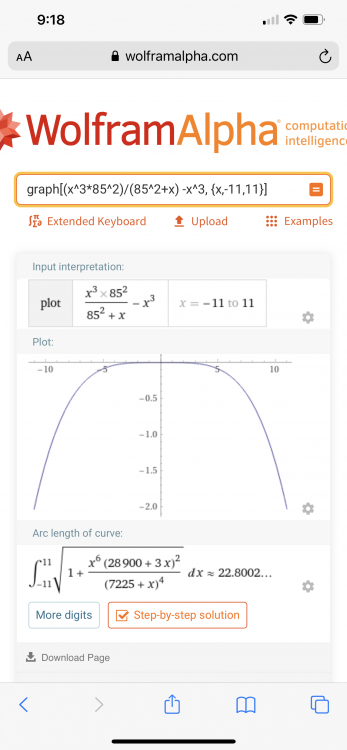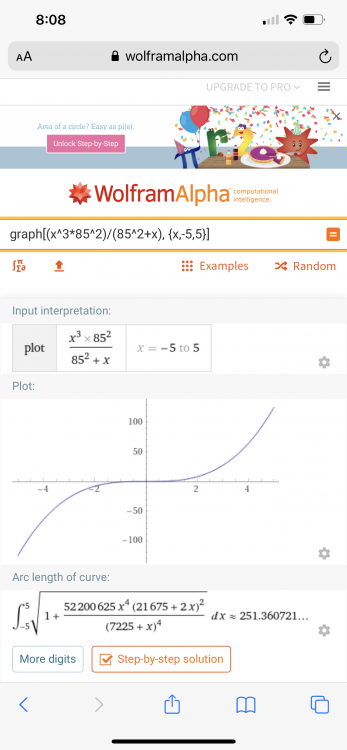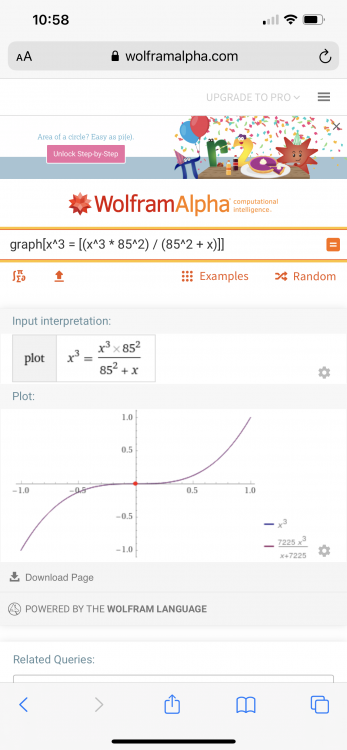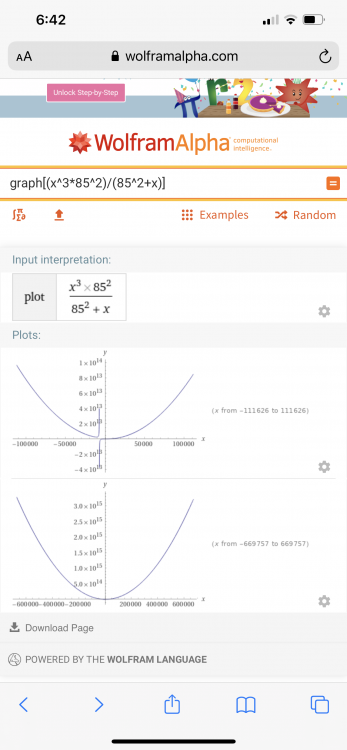-
Posts
421 -
Joined
-
Last visited
-
Days Won
1
Content Type
Profiles
Forums
Events
Everything posted by Trurl
-
Why? Because it is p^2 minus p^2 derived. Same with second equation. It is just how I derived the equations. Does it work? I don’t know. But I am simply comparing patterns in division. Obviously you tried test values. Did it work with your values? i will run more test values. Let me know if you have any more questions or your test values don’t work.
- 188 replies
-
-1
-
Note: These are 3 separate groups of equations. They are separated by lines. \[p^3 - \frac {N^2 p^3} {N^2 + p}\] ___ ___ ___ ___ ___ ___ ___ ___ ___ ___ ___ ___ ___ ___ ___ ___ ___ _ The above equation should be close to zero, but sometimes the error is closer to 1 \[\frac{N p^3}{N^2+p}=\text{fraction}\] because q = N/p \[\frac{\text{fraction}}{q}=\frac{\text{fraction}}{\frac{N}{p}}\] \[N \sqrt{\frac{\text{fraction}}{\frac{N}{p}}}=p^2\] ___________________________________________________________________ The above equations are the second example. \[q = \sqrt {\frac {N q^2 + q} {N}}\] square q \[q^2-\frac{ \left(N q^2+q\right)}{N}\] In the case where N = 85 and q = 17, \[q^2 - (N*q^2 + q)/ N\] is 1/x or 1/5 or 0.2 \[0.2 * 85 = x\] or 5 in this example These are 3 separate groups of equations. They are separated by lines.
-
Here are my equations to review. There are quite possibly hundreds of variations. This is what I meant by isolating x and y in the equations. I mean isolated p and q separately, knowing only N. There are 3 equations. I am just getting used to Latex so I hope this is readable. If necessary I will post corrections. But it is these 3 separate equations I want you to test. p^3 - (p^3*N^2) / (N^2 + p) \[p^3 - \frac {N^2 p^3} {N^2 + p}\] ___ ___ ___ ___ ___ ___ ___ ___ ___ ___ ___ ___ ___ ___ ___ ___ ___ _ The above equation should be close to zero, but sometimes the error is closer to 1 (p^3 *N) / (N^2 + p) = fraction fraction/ q = fraction / (N /p) Sqrt[fraction / (N /p)] * N = p^2 \[\frac{N p^3}{N^2+p}=\text{fraction}\] ___________________________________________________________________ The above equations are the second example. q = Sqrt[(N*q^2 + q)/ N] q^2 - (N*q^2 + q)/ N is approximately 0 In the case where N = 85 and q = 17, q^2 - (N*q^2 + q)/ N is 1/x or 1/5 or 0.2 0.2 * 85 = x or 5 in this example \[q^2 - \frac {0\text {approximately}\t ext {is}\left (N q^2 + q \right)} {N}\] Final equations are a proposed method for finding q, knowing only N I have been working with the first equation for awhile. The other 2 are based on the first, but still need tried. There is nothing fancy here. I am just comparing how numbers divide.
-
The new "y isolated" equation does not work. It was based on the "x isolated" equation, but does not work. Does anyone see a way to isolate y knowing only pnp?
-
\frac {\text {pnp}^3 y^3 - \text {pnp} y^2 + \text {pnp}} {\text {pnp} y^3 + y^2} Yes that is exactly it. But does it work? I think it works, but does it prove useful? I call "N": pnp and "p and q": "x and y" Given N (I call pnp) we estimate x. And in the latest post I am trying to find y, the larger factor. \frac {\text {pnp}^3 y^3 - \text {pnp} y^2 + \text {pnp}} {\text {pnp} y^3 + y^2} \frac {\text {pnp}^3 y^3 - \text {pnp} y^2 + \text {pnp}} {\text {pnp} y^3 + y^2} \[\frac {\text {pnp}^3 y^3 - \text {pnp} y^2 + \t ext {pnp}} {\text {pnp} y^3 + y^2}\]
-
(y^3 * pnp^3 - y^2 * pnp + pnp) / (y^3 * pnp + y^2) = pnp^2 y is now isolated as x was. Ready to simplify. No, you uncovered a weakness of the PC method. That is that the error varies between 0 and 1. The first SemiPrime was close to 94. I factored the second to be sure. But by working with the equation for years that it could be a smaller Prime factor. The trouble is without knowing the true error testing numbers less than 94 in the example, narrows the selection but not more useful than division. We need exact results and not an estimate. But does that exist? 3 possible solutions: Isolate y and compare to x Investigate the curve of the graph of the equation between 0 and 1 Find a pattern in the error. An error not spanning such a large range. 3^4/(8637^2+3)=0.000001732 3 < 94 but the number of importance is 0.00001732. It causes 3 to be hidden when starting at 1 and not zero. Questions are good. It is quite possible I am wrong. But I see something or I wouldn’t have put so much effort. From Wikipedia: Semiprimes are highly useful in the area of cryptography and number theory, most notably in public key cryptography, where they are used by RSA and pseudorandom number generators such as Blum Blum Shub. These methods rely on the fact that finding two large primes and multiplying them together (resulting in a semiprime) is computationally simple, whereas finding the original factors appears to be difficult. In the RSA Factoring Challenge, RSA Security offered prizes for the factoring of specific large semiprimes and several prizes were awarded. The original RSA Factoring Challenge was issued in 1991, and was replaced in 2001 by the New RSA Factoring Challenge, which was later withdrawn in 2007.[7] https://en.m.wikipedia.org/wiki/Semiprime
-
Ok. I'll try two examples: 8633, 8637. Both are semi primes. NSolve [( x^4/((8637)^2 + x)) == 1] x≈-92.935 x≈92.935 NSolve [( x^4/((8633)^2 + x)) == 1] x≈-92.914 x≈92.914 @Trurl Is this helpful for someone looking for the prime factors of the numbers 8633 and 8637? If so, how? Yes the numbers are too close to estimate. But I still have faith in the Pappy Craylar method. After all 3 < 92 and 3^4/(8637^2+3)=0.000001732 Which Is close to zero where the error is supposed to be near anyway. Remember when I said we needed to test the logarithmic curve of 3*5; 3*7; 3*11 and so forth to find the error change as 3*Prime number increases? I know your smart and are looking for holes in the PC method. That is what you are supposed to do. But I know you are smart enough to understand it. A fix to to great number of possible estimates is to isolate y as x is isolated. Then we will see a better picture of what is happening when SemiPrimes are factored.
-
y^2 = ((pnp*y^2+y)/pnp) This is one of many isolated y’s. I have much more to share. But I want readers of this to see how simple the equation is. Remember that this thread is called Simple yet Interesting. 😒
-
I will post here how the equations were derived if anyone is interested. My question to you is: Do you agree the Pappy Craylar method is significant to factorization? My second question to you is there a list of all the ciphers that use SemiPrimes? The hash ciphers the message but to have public keys you need a one-way function. But do one-way functions exist? I read on the web the question of whether math is created or discovered. Something that hasn’t been solved is impossible to it’s discovered it is not. Was it your understanding that was discovered? I cannot factor without error. So large SemiPrime increase in range between zero and one. But if I can post here with the derivation of x, maybe a similar equation can be found for y, the larger factor.
-
Thanks @Sensei and @Ghideon The error from the equation to x^4 changes as the 2 Prime products change in the distance between the factors. But much of the usefulness of the Pappy Craylar method relies on the X factor being exact. I prose isolating y (the larger factor) as x has been isolated. The distance between x and y should prove useful. Again thanks for the help with large digits. Now we have a meaningful test of the PC method.
-
PNP = 85 NSolve [( x^4/(85^2 + x)) == 1] 85 {{x -> 9.22249}, {x -> -0.00294118 + 9.21954 I}, {x -> -0.00294118 - 9.21954 I}, {x -> -9.2166}} Clear[x] NSolve [( x^4/(35794234179725868774991807832568455403003778024228226193532908\ 190484670252364677411513516111204504060317568667^2 + x)) == 1] Clear[x] NSolve [( x^4/(35794234179725868774991807832568455403003778024228226193532908\ 190484670252364677411513516111204504060317568667^2 + x)) == 1] Clear[x] NSolve [( x^4/((6863*7759)^2 + x)) == 1] {{x -> 7297.26}, {x -> 0. + 7297.26 I}, {x -> 0. - 7297.26 I}, {x -> -7297.26}} Clear[x] NSolve [( x^4/((6863*7759)^2 + x)) == 0.8] {{x -> 6901.32}, {x -> 0. + 6901.32 I}, {x -> 0. - 6901.32 I}, {x -> -6901.32}} I don't know why but Mathematica won't solve my large RSA number. Above are 3 different attempts. PNP=85 at 1, you have a value of 9.22249. This means the unknown x is less that 9.22249. Ignore the imaginary numbers because you should be only concerned with the real numbers. You can be sure that those weird values (often imaginary) are not the Prime factors. Thanks for the reply, Ghideon. I think it is clear it works with small values. But as PNP gets larger, the error does not increase. The errors are the same. The error differs as the distance from x to PNP changes. I don't yet know the error or the precision of float points. Mathematica should be able to crunch it. Look at the 3rd program paragraph. I tested an error of 0.8 from 0 to the computed value of the equation. I have never programmed hundred digit+ numbers. I think Mathematica will handle the calculation but as I show in the 2 program paragraph above it just refuses to compute. I thought that maybe someone on this forum would know how to program a hundred digit number and not have a error in floats. I know it is possible, but to use floats without rounding requires a program. I have looked for such programs in C++ but it was so complex. I chose Mathematica to have a ready made program, but it must not see the 100 digit number as a number. But the problem is logic and not number crunching. If I am correct and the equation: x^4/(85^2+x) error is always below 1 then we could pinpoint x.
-
I too have had such writing problems. You are writing for a message board now and it is informal. For essays you have to outline your ideas. Write a draft. You think faster than you write that is why you outline with brief descriptions. Easy to understand points are a must. If you jump between topics which make sense to you and not the reader you will never get a point across. Simplify. It is like I know how it works but how do I explain it. You are just trying to form ideas and put them into grammatically correct sentences at the same time. Slow you pace and write ideas on scratch paper. I was taking a master’s class in adult education. They told me I was writing musings for the internet. I thought the ideas behind the writing was the most important. But presentation of the idea is a tricky art. Knowing science is one thing but teaching it is it’s own art. Same with writing. Clarity and explaining your point is more important than trying to explain everything at once. Too many ideas to ideas is usually good. You just have to record them before you lose them. Document with a journal.
-
Your work on dividing the sphere is interesting. As a graphic artist I appreciate all the lines drawn on the volleyball. What are your applications? The one I think of is antenna signal propagation. The shape of impedance and conductance on the antenna would be the division of a sphere that changes size and shape. If you use the division of the sphere as a reference, you have the 3D way to explain electricity, magnetism, and waves; like a sine curve is a reference to the 2D.
-
Clear [x, pnp, f]; pnp = 85 For [x = 3, (x < (pnp/2)), (x = x + 2) ; f[x] = x^4/(pnp^2 + x) If[f[x] < 1, Print[x]] ] 85 $RecursionLimit::reclim2: Recursion depth of 1024 exceeded during evaluation of If[f[5]<1,Print[x]]. $RecursionLimit::reclim2: Recursion depth of 1024 exceeded during evaluation of If[f[7]<1,Print[x]]. $RecursionLimit::reclim2: Recursion depth of 1024 exceeded during evaluation of If[f[9]<1,Print[x]]. General::stop: Further output of $RecursionLimit::reclim2 will be suppressed during this calculation. Clear [x, pnp, y]; pnp = 85 For [x = 3, (x < (pnp/2)), (x = x + 2) ; y = x^4/(pnp^2 + x) Print[y]] 85 y (125 Null)/1446 (2401 Null)/7232 (6561 Null)/7234 (14641 Null)/7236 (28561 Null)/7238 (10125 Null)/1448 (4913 Null)/426 (130321 Null)/7244 (194481 Null)/7246 (279841 Null)/7248 (3125 Null)/58 (531441 Null)/7252 (707281 Null)/7254 (923521 Null)/7256 (1185921 Null)/7258 (300125 Null)/1452 (1874161 Null)/7262 (2313441 Null)/7264 (2825761 Null)/7266 Well I think the syntax is correct now. Mathematica does not want to do what I tell it. I showed the Null because if you divide those values without the Null you get the answer. I am only looking for x values that f[x] <1 (near zero). Again if anyone can tell me how to perform math on hundred-digit numbers let me know. Mathematica would handle it, but the recursion error is in my way. I'm so close. I want to be able to just cut in past pnp and find the zero values. Also note the equation is simplified. That is thanks to an unanimous post. Mathematica simplified in one keyword what I was unable to do on paper. I think I'm going to turn to free Linux opensource math programs. Thanks Sensei for promptly answering my post. I think the problem is that Mathematica expects an integer value, but I have seen it use decimals many times before. It is just frustrating when the computer language doesn't do what you want. But I don't mind if someone programs it before I do, because that may lead to the Pappy Craylar Method being proven true.
-
All those thoughts are a blessing. Not racing thoughts but the potential ideas. If you are control of those thoughts you can focus them. Too many ideas is better than no ideas. That is one heck of a brainstorming session. You should not write in proper pose. Instead write down ideas and create outlines. I listened to an Audible book on how to create things by writing. It can help you write a book but it helps in all areas of creativity. The book is called Accidental Genius by Mark Levy.
-
Thanks. The code is that simple. Put it seem to Print f of x instead of x. In[63]:= Clear x Clear pnp pnp = 85 f[x] = ((x ^ 3 * pnp^2) / (pnp^2 + x) - x^3) x = 3; While [f[x_] < 1, Print[x]; (x + 2)] Out[63]= 3 Clear Out[64]= 85 Clear Out[65]= 85 Out[66]= -(81/7228)
-
Can anyone fix this code? Shout out to Sensei. 2 lines of code in Mathematica. Variables can be floats. No errors just runs. Clear x Clear pnp pnp = 85 For [x = 3 , x < (pnp/2), (x + 2); [x] := If [{((x ^ 3 * pnp^2) / (pnp^2 + x) - x^3) < 1.0}] ]
-
I do believe in doing science. I just wanted to point out the dilemma. It is the same in business. And politics. I guess you just have to make the best decisions you can. Some stuff is small but with others you have to rely on intuition. Many years ago I was put into a small leadership position of a group of 20 people. I was never in a leadership position before and it showed. I was an engineer student and I thought in my l leadership role that would help me “think” about all our decisions. I was wrong. Managing people, completing objectives, and making decisions is a whole other skill set. I just wanted to point out science is also limited. You guys have good answers, but more than science applies with decisions. We can’t be responsible for what is done with our creations or can we? I don’t like when science is referred to as a religion or do I think as Christianity as one. Instead they are a set of beliefs we base our decisions on. In my beliefs I don’t think we are any more in control with science. There is just too much unknown. By being out of control in science I mean we are not in total control when creating something. That is not me saying that. It comes from book on Creativity and Flow. Some decisions are insignificant but even if we are just a scientist creating or someone using that scientist’s knowledge we better make the best decision possible. Those are my thoughts. Like I said you guys did give good answers. I am under the assumption that science directly relates to technology. I have never experienced it otherwise. Just as some discredit Christianity with studying it, I am lost when science doesn’t result in knowledge or technology. The fruit of knowledge is what caused all these problems in the first place.😉 You guys are right curiosity is a good thing. The odds are that man eats the apple every time.
-
Why do I do science? I just replied to a tweet on Twitter with the following tweet: Science and money both solve problems. But both cause new problems. Like winning a 100 million then going bankrupt or building a bomb and causing arms race. Blatant example where science doesn’t solve anything. Don’t get me wrong I have loved science all my life. But what is its underlying meaning or goal? Fix one problem; five new ones. Ones that don’t exist before the science. I ask before if a utopian world could exist through science but I couldn’t define utopian. But those who answered said they did science to improve the World. I like that answer, but when tweeting the above made me wonder why I do science? I should include a link to the tweet. The original tweet the author talk about how we use technology to track the entire internet and the computer scientists would rollover in their grave if they knew what their technology was being used for. When I say,”why do I do science?” I am not trying to trash science. I just wonder is it doing what we intend it to and are we even in control of it?
-
Ok you want a pattern. I saw a post here about a debate if math was created or invented. The same applies to patterns. The subconscious defines the pattern. I say a pattern is a pattern. I look for them. And share them with the goal that others will see them too. But the fact is you should see the same pattern. Maybe someone has seen the pattern and is keeping it secret. In the hands of a capable mathematician this could be an attack on RSA. But take the previous equation x^3 approx - x^3 And plug in a known x, say my favorite 5. Let pnp = the y value of the graph The hypothesis is that x of the graph will approach an x of zero where pnp of y equals a semiPrime. In other words, when x =0 you will find every SemiPrime that has a factor of 5 will be found. (You can invert x and y for y =0 so that the graph is y=f(x).)
-
No you are right there is no pattern in Primes in this graph. Instead it shows the value of the smaller semi-Prime. Pnp =x*y. x^3 approximate -x^3 We subtract to make x appear around y equals zero so we know where to look for it. The pattern of Primes comes from graphing all pnp’s. If you know a number is a factor of a semi-Prime you know it is Prime. I did not show that in the last graph. The last graph is to factor the semi-Prime.
-
-
There are 2 patterns. The one found in this graph where all possible x’s are graphed against a know pnp. And the other graphs that compare the known pnp to a calculated pnp. This graph is the first case. It is definitely logarithmic. In fact, I think it is related to the normal distribution. I show -5 to 5. Yes I know I must know x = 5 when looking at the graph. But you must admit when you plug and chug different values x, the results should be approaching x to the third. The other 3 equations in this thread still apply. They are just overly complex. The graphs of those equations still have patterns. The pattern of this graph is logarithmic. But the advantage of graphing is to find the derivative or perform other operations. The equation itself in is a pattern.
-
You are correct the equation is only true for zero for integers. But as you also know I am only looking for decimal approximations. An x of 5 and a pnp of 85 fall within reasonable range. I am looking for numbers for computation. The application of the cubed root of 124.9136 is close enough to the cubed root of 125.
-
Sorry try Remember there is no guarantee it works, but it is simple enough to test. x^3 = [(x^3 * pnp^2) / (pnp^2 + x)] try pnp=85 and an x of 5 Then test more values.






